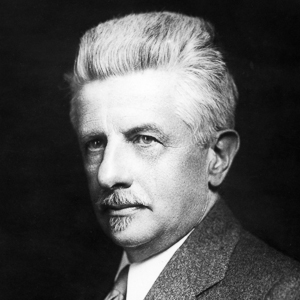When the American Association of University Professors was founded in January 1915, higher education bore little resemblance to the system that exists in this country today. The degrees awarded each year by America’s colleges and universities numbered in the tens of thousands rather than in the millions, and the student body was overwhelmingly white, male, and drawn from the social elite. Faculty members did not widely enjoy due-process protections; on the contrary, colleges and universities often operated under governments “of men and not of laws,” to quote from the AAUP’s first investigative report. Lacking tenure, the majority of faculty members at the time served on what would now be regarded as contingent appointments.
The creation of the AAUP was preceded by work undertaken in 1914 by the Joint Committee on Academic Freedom and Tenure, also known as the “committee of nine.” This committee, which included three representatives each from the American Economic Association, the American Sociological Society, and the American Political Science Association and was headed by Columbia University economics professor Edwin R. A. Seligman, was charged with examining academic freedom issues and investigating individual cases. The difficulties of undertaking this work through separate disciplinary societies made apparent the need for a more broadly conceived faculty association.
It was against this backdrop, and in the context of a larger movement toward the consolidation of professional identity through representative national organizations, that the AAUP was established.
The five illustrated banners and timeline below, prepared in 2015 in celebration of the AAUP's centennial, highlight key events in the AAUP's first century. Please note that the banners appear below in the form of large .pdf files, and there may be some delay in loading the images.
Centennial banner 1915-1920
Centennial banner 1921-1955
Centennial banner 1956-1969
Centennial banner 1970-2000
Centennial banner 2001-2015
Timeline: The AAUP’s First Century
| 1915 |
The AAUP is founded at an organizational meeting held in New York City on January 1 and 2. At the meeting, John Dewey, a professor of education and psychology at Columbia University, takes office as the first president, and Arthur O. Lovejoy, a philosophy professor at Johns Hopkins University, becomes the first secretary. Dewey appoints Edwin R. A. Seligman, the economist who had led the joint “committee of nine,” to chair a committee charged with considering questions of academic freedom and tenure—a body that soon evolves into Committee A on Academic Freedom and Tenure. Listen to an audio clip in which Lovejoy discusses planning an organizing meeting in Baltimore that preceded the public founding of the AAUP in New York and to Lovejoy's account of how he persuaded Dewey to serve as the AAUP's first president. |
.jpg) The Chemists' Club, site of the meeting at which the AAUP was founded |
|
|
In March 1915, seventeen faculty members at the University of Utah resign in protest after the appointments of four of their colleagues are abruptly terminated by the president and board of trustees. A month later, the AAUP, at Lovejoy’s urging, launches an investigation into violations of principles of academic freedom and tenure at Utah—the first of five investigations that the new Association will undertake in its first year as it puts its principles into practice. Listen to a recording of Lovejoy recalling his role in launching the first investigation. |
|
.jpg) Scott Nearing, an economics professor at the University of Pennsylvania, came under fire from conservative alumni for his public opposition to child labor. Nearing became the subject of the AAUP’s fourth investigation after the board of trustees— overruling the recommendation of the dean, department chair, and faculty—chose not to renew his appointment. |
|
|
A list of “charter members” published in May 1915 includes the names of more than nine hundred professors from sixty-one institutions. Membership is by nomination and election. |
|
|
In December, the AAUP publishes the inaugural volume of the Bulletin of the American Association of University Professors. Included in the Bulletin is the foundational statement now known as the 1915 Declaration of Principles on Academic Freedom and Academic Tenure, which states, “Once appointed, the scholar has professional functions to perform in which the appointing authorities have neither competency nor moral right to intervene. The responsibility of the university teacher is primarily to the public itself, and to the judgment of his own profession." |
|
| 1916 |
The AAUP adopts a resolution to create Committee T on the Place and Function of Faculties in University Government and Administration. This committee (now the Committee on College and University Governance) becomes central to the Association’s effort to promote a strong faculty role in the governance of higher education institutions. |
.jpg) Geographical distribution of AAUP members in early 1916 |
|
| 1917 |
The United States enters World War I. |
|
The annual meeting votes to establish Committee W on the Status of Women in College and University Faculties “to report upon . . . the appointment of women to the higher academic positions; upon the opportunities for advancement now offered and that should be offered to women of ability and scholarship in the various fields of college and university teaching; and upon all other problems involved in the determination of the present or the desirable status of women in college and university faculties.” |
|
| 1918 |
World War I ends. |
| 1919 |
Writing in his president’s message that economic circumstances in the United States following World War I had made it impossible “that this, the only general professional society of university teachers, should any longer ignore the economic side of the teacher’s calling,” Arthur O. Lovejoy announces the creation of the Committee on the Economic Condition of the Profession. |
|
|
|
| 1920 |
The Nineteenth Amendment is ratified, giving women the right to vote. |
| 1925 |
The AAUP participates in the drafting of the Conference Statement on Academic Freedom and Tenure—the first jointly formulated statement to enumerate principles of academic freedom—at a meeting of higher education organizations. |
| 1928 |
AAUP members in Iowa establish the first state conference of AAUP chapters. |
| 1929 |
The US stock market crashes, bringing the “roaring twenties” to a sudden end and marking the beginning of the decade-long Great Depression. |
| 1930 |
The AAUP’s national office is established. H. W. Tyler, a recently retired mathematics professor from the Massachusetts Institute of Technology who had followed Lovejoy as second secretary of the Association and served in that capacity until 1930, heads the new office as general secretary. |
.jpg) H. W. Tyler |
|
| 1931 |
The AAUP’s membership exceeds ten thousand. |
| 1932 |
Franklin Delano Roosevelt is elected president and pledges “a new deal for the American people.” |
.jpg) Albert Einstein’s AAUP membership card. Einstein was an AAUP member from 1935 until his death in 1955. |
|
| 1936 |
The nonreappointment of Jerome Davis, a long-serving professor at Yale Divinity School who had advocated for organized labor and other social causes, brings to the fore the need for a probationary period of standard length. Concern over this case and other, similar ones becomes a factor leading to the formulation of the 1940 Statement of Principles on Academic Freedom and Tenure. |
| 1937 |
McGraw-Hill publishes Depression, Recovery, and Higher Education, a book-length report by a special committee of the AAUP that addresses the consequences of the Great Depression for faculty members, students, and institutions. The volume anticipates future reports on the economic status of the profession. |
| 1938 |
The AAUP establishes policies for formally censuring administrations for violations of principles of academic freedom and tenure and begins publishing censure lists in the Bulletin. |
| 1940 |
A series of joint conferences begun in the mid-1930s between the Association of American Colleges (now the Association of American Colleges and Universities) and the AAUP culminates in agreement on a reformulation of the principles laid out in the 1925 Conference Statement on Academic Freedom and Tenure. The resulting 1940 Statement of Principles on Academic Freedom and Tenure defines faculty rights and responsibilities with regard to speech in the classroom, extramural speech, and research and establishes a maximum seven-year probationary period for tenure. |
| 1941 |
The United States enters World War II after the Japanese attack on Pearl Harbor. |
| 1944 |
The Servicemen’s Readjustment Act of 1944, commonly referred to as the GI Bill, is signed into law. Millions of veterans enter college in the years following the law’s passage, nearly doubling the student population. |
.jpg) President Franklin Delano Roosevelt signs the GI Bill. |
|
| 1945 |
World War II ends. |
| 1946 |
The President’s Commission on Higher Education is charged with examining the role of higher education in postwar America. A year later, the resulting Truman Commission Report recommends a massive expansion of college enrollments and the establishment of a network of community colleges. |
| 1947 |
The AAUP’s membership exceeds twenty thousand. |
| 1948 |
The AAUP’s Committee on the Economic Status of the Profession publishes the results of its first survey of faculty salaries. |
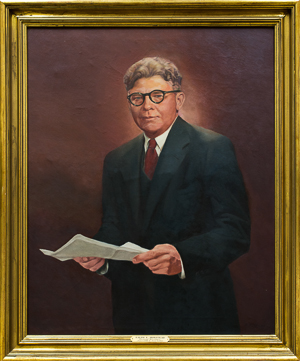 Ralph Himstead, the AAUP's general secretary from 1936 to 1955 |
|
| 1949 |
After releasing an investigation of Evansville College (and declining to impose censure), the AAUP enters a period of relative inactivity. |
| 1954 |
The US Supreme Court rules in Brown v. Board of Education that “separate educational facilities are inherently unequal.” |
.jpg) A scene from the 1954 annual meeting |
|
| 1955 |
The election of new Council members and officers, together with changes in the AAUP’s national office, brings to an end the AAUP’s quiescence during the McCarthy era. |
| 1956 |
Committee A on Academic Freedom and Tenure issues the first part of Academic Freedom and Tenure in the Quest for National Security, an investigation of multiple cases that had been neglected in the preceding years. Unprecedented in its scope, the report does much to repair the Association’s reputation as a defender of academic freedom and due process. |
| 1957 |
Committee A formulates the first version of the Recommended Institutional Regulations on Academic Freedom and Tenure. These recommended regulations, derived from the Association’s key statements, are subsequently integrated into the policies of colleges and universities across the United States. |
|
The US Supreme Court upholds the right of Paul Sweezy, a university lecturer, to decline to answer questions posed by a state body investigating subversive activities. Justice Felix Frankfurter, in his concurrence in Sweezy v. New Hampshire, establishes the constitutional doctrine of academic freedom when he cites “four essential freedoms of a university—to determine for itself on academic grounds who may teach, what may be taught, how it shall be taught, and who may be admitted to study.” |
|
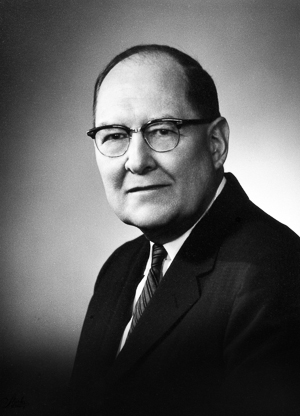 Ralph F. Fuchs, the AAUP’s general secretary from 1955 to 1957 |
|
| 1958 |
The AAUP enters the legal arena, filing its first amicus brief in the US Supreme Court on behalf of Lloyd Barenblatt, a University of Michigan teaching fellow who had refused to answer questions posed by the House Un-American Activities Committee. |
| 1959 |
The Council of State and Regional Conferences, the predecessor to the AAUP’s Assembly of State Conferences, is organized and holds its first meeting. |
|
The annual meeting approves an amendment to the AAUP’s constitution that replaces the system of membership by nomination with one of membership by application; membership exceeds forty thousand. |
|
| 1960 |
Committee A on Academic Freedom and Tenure begins to address the issue of students’ academic freedom in response to what committee chair David Fellman describes as “events around the country, and particularly in the South” that confronted students “with many questions which in some fashion relate to their general claim to academic freedom,” including “students’ activities in connection with the desegregation controversy.” |
|
Monmouth College and the University of Miami become the first institutions to be investigated by Committee T for infringements of governance standards. |
|
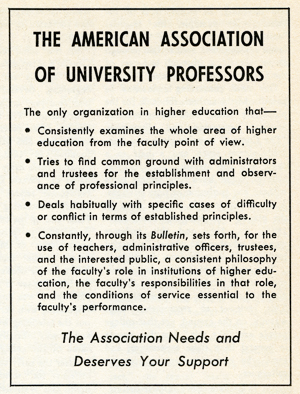 1960 advertisement for the AAUP |
|
| 1963 |
Faculty members at Nassau Community College form the first AAUP chapter on a community college campus. |
| 1964 |
The Civil Rights Act becomes law. |
| 1965 |
The AAUP establishes a Special Committee on the Representation of Economic Interests to consider extending the activities of the Association into collective bargaining. |
| 1966 |
Professors at St. John’s University begin the first major US faculty strike over the administration’s summary dismissal of a group of their colleagues. The AAUP conducts an investigation into the administration’s actions but does not support the strike. |
|
The AAUP issues its central policy document on the faculty’s role in governance, the 1966 Statement on Government of Colleges and Universities. Formulated jointly by the AAUP, the American Council on Education, and the Association of Governing Boards of Universities and Colleges, the statement calls for cooperation among faculties, administrations, and governing boards and notes that the faculty should have “primary responsibility for such fundamental areas as curriculum, subject matter and methods of instruction, research, faculty status, and those aspects of student life which relate to the educational process.” |
|
|
The AAUP issues the Statement on Professional Ethics, which delineates the responsibilities that accompany the rights of members of the academic profession. |
|
| 1967 |
In a development of which the national AAUP is initially unaware, faculty members at Belleville Area College (now Southwestern Illinois College) vote to designate their chapter as their exclusive representative in bargaining, making it the first AAUP collective bargaining chapter. |
 Martin Luther King Jr. speaks against the war in Vietnam at the Saint Paul campus of the University of Minnesota in April 1967. Photograph from the Minnesota Historical Society (CC BY-SA 2.0) |
|
|
The US Supreme Court holds in Keyishian v. Board of Regents that states cannot terminate the appointments of faculty members on the basis of their refusal to sign a loyalty oath disavowing membership in the Communist Party. Justice William Brennan writes in his majority ruling: “Our Nation is deeply committed to safeguarding academic freedom, which is of transcendent value to all of us and not merely to the teachers concerned. That freedom is therefore a special concern of the First Amendment, which does not tolerate laws that cast a pall of orthodoxy over the classroom.” |
|
|
A committee including representatives from the AAUP and from student and administrator groups formulates the Joint Statement on Rights and Freedoms of Students. |
|
| 1968 |
The AAUP publishes the first edition of Policy Documents and Reports, better known as the Redbook. |
|
The AAUP issues The Role of the Faculty in the Accrediting of Colleges and Universities. |
|
| 1969 |
AAUP membership peaks at around ninety thousand. |
|
The number of US military personnel in Vietnam peaks at more than 543,000. |
|
| 1970 |
The Council adopts a set of interpretive comments appended to the 1940 Statement of Principles on Academic Freedom and Tenure. Known as the 1970 Interpretive Comments, these footnotes are the result of joint meetings of the AAUP and the Association of American Colleges and reflect the experience gained over thirty years of applying the principles set forth in the 1940 Statement. |
.jpg) 1970 annual meeting |
|
|
National Guard troops kill four students during a massive antiwar protest at Kent State University. |
|
|
The faculties at Rutgers, St. John’s, and Oakland Universities become the first at four-year institutions to be represented in collective bargaining by the AAUP. |
|
|
Committee W on the Status of Women in the Academic Profession is reactivated after an extended period of dormancy. |
|
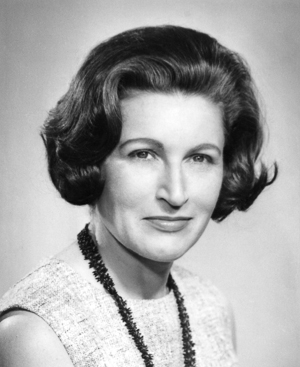 Alice S. Rossi, chair of the reactivated Committee W |
|
| 1971 |
After much internal debate, the Council votes to “pursue collective bargaining . . . as a major additional way of realizing the Association’s goals in higher education” and to “allocate such resources and staff as are necessary for a vigorous selective development of this activity beyond present levels.” |
|
The Special Committee on Nontenured Faculty is established “in recognition of the increasing numbers of faculty and Association members who are nontenured and in further recognition of the need to give special consideration to their status and rights.” |
|
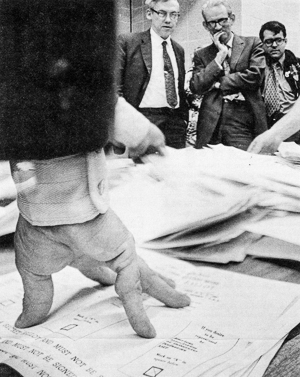 Votes are tallied in the 1971 collective bargaining election at the University of Rhode Island. The AAUP defeated the National Education Association in the election, and the University of Rhode Island became the second state university on the East Coast to be represented by the AAUP in bargaining. |
|
| 1972 |
Title IX becomes law, barring discrimination based on sex at educational institutions that receive federal aid. |
| 1973 |
US military involvement in the Vietnam War ends. |
|
The AAUP’s collective bargaining chapters establish the Collective Bargaining Caucus, the predecessor to the Collective Bargaining Congress. |
|
.jpg) National office staff members Jordan E. Kurland, Woodley B. Osborne, Matthew W. Finkin, and Charles L. Haslam (from left to right) after a National Labor Relations Board hearing |
|
|
The annual meeting adopts the first Statement on Collective Bargaining. |
|
|
Committee L on Predominantly Black Institutions is established “to develop ways and means of making the national AAUP more responsive to the needs of these institutions and their constituents.” The committee will later evolve into the current Committee on Historically Black Institutions and Scholars of Color. |
|
.jpg) A Committee L meeting |
|
| 1975 |
The Collective Bargaining Congress is formed. |
|
The AAUP begins to disaggregate salary data by sex in its annual Report on the Economic Status of the Profession, providing concrete information about salary discrimination. |
|
|
The Association issues the Statement on Teaching Evaluation. |
|
| 1978 |
Committee A on Academic Freedom and Tenure approves the subcommittee report On Full-Time Non-tenure-track Appointments, the first major AAUP policy document to examine the problems associated with contingent faculty appointments. The report concludes that the use of such appointments is “inequitable, harmful to morale, and a threat to academic freedom.” |
| 1979 |
The Bulletin of the AAUP merges with the Academe newsletter and changes its name to Academe: Bulletin of the AAUP. |
|
The first AAUP Collective Bargaining Institute—the predecessor to the Summer Institute—is held at Eastern Michigan University. |
|
| 1980 |
In its ruling in NLRB v. Yeshiva, the Supreme Court labels most tenured and tenure-track faculty members at private institutions “managerial” employees, thus denying them a protected right to bargain collectively. Justice William Brennan dissents, writing, “The notion that a faculty member’s professional competence could depend on his undivided loyalty to management is antithetical to the whole concept of academic freedom.” |
 Ernst Benjamin, the AAUP’s general secretary from 1984 to 1994, at the Association’s former office on Fourteenth Street NW in Washington, DC |
|
| 1988 |
The AAUP issues the Statement on Academic Government for Institutions Engaged in Collective Bargaining, which holds that “collective bargaining should not replace, but rather should ensure, effective traditional forms of shared governance.” |
| 1989 |
The for-profit University of Phoenix establishes its “online campus,” the first to offer bachelor’s and master’s degrees. |
| 1990 |
The Council approves the creation of a standing Committee on Part-Time and Term-Appointed Faculty (now the Committee on Contingency and the Profession). |
|
A meeting of the AAUP and other organizations at Wolf Trap produces the Statement on Academic Freedom and Artistic Expression. |
|
| 1991 |
The AAUP establishes a procedure for sanctioning institutions “for substantial noncompliance with standards of academic governance.” |
| 1994 |
Mandatory retirement for tenured faculty is eliminated. |
|
Lindenwood College becomes the first institution to be placed on the sanction list following an investigation into the administration’s dismantling of faculty governance structures. |
|
.jpg) A teach-in at Bennington College |
|
| 2001 |
The AAUP issues the Statement of Principles on Family Responsibilities and Academic Work, significantly updating an earlier statement on provisions for child-rearing. |
|
On September 11, terrorists crash hijacked airplanes into the World Trade Center and the Pentagon. The US government responds to the attacks by passing the Patriot Act, creating the Department of Homeland Security, and launching wars in Afghanistan and Iraq. |
|
.jpg) A Campus Equity Week Rally in Trenton, NJ |
|
| 2003 |
The Supreme Court, in its decisions in Grutter v. Bollinger and Gratz v. Bollinger, upholds the use of affirmative action in college and university admissions, citing the educational benefits of diversity. |
|
The AAUP’s Special Committee on Academic Freedom and National Security in a Time of Crisis issues its report on the risks to academic freedom and free inquiry posed by the response to the September 11 attacks. |
|
.jpg) Jane Buck, then president of the AAUP, congratulates US Representative Bernie Sanders, who received the Henry T. Yost Award in 2004 for his leadership on higher education issues. |
|
| 2005 |
The Collective Bargaining Congress adopts and the Council endorses Academic Unionism, a statement that delineates the principles underlying the AAUP’s approach to collective bargaining for faculty members and academic professionals. |
| 2006 |
In a ruling with potential negative implications for academic freedom, the US Supreme Court in Garcetti v. Ceballos restricts speech by public employees on matters related to their “official duties.” |
| 2007 |
The report Hurricane Katrina and New Orleans Universities, written by a special nine-member investigating committee, examines violations of AAUP standards at five New Orleans institutions in the aftermath of the 2005 storm. Four administrations are censured, but ameliorative actions taken by the institutions in the following years lead to the lifting of the censures. |
|
The bursting of the bubble in the US housing market triggers a financial crisis and an extended economic downturn. Disinvestment in public higher education accelerates as the Great Recession ushers in new austerity measures. |
|
| 2009 |
A subcommittee of Committee A on Academic Freedom and Tenure responds to the issues raised by the Supreme Court’s Garcetti ruling, arguing forcefully for the importance of protecting an independent faculty voice. |
.jpg) Students and faculty at a rally supporting Oakland University professors (courtesy Oakland Post) |
|
| 2010 |
The AAUP publishes the first volume of its annual Journal of Academic Freedom. |
| 2011 |
A new law passed in Wisconsin denies many public employees, including faculty members at state colleges and universities, most collective bargaining rights. A similar measure passes in Ohio but is later repealed in a veto referendum. |
|
The AAUP introduces Academe Blog. |
|
| 2013 |
On January 1, the AAUP Foundation, a charitable organization, is created as part of an organizational restructuring.* |
.jpg) A workshop at the AAUP Summer Institute |
|
| 2014 |
The AAUP’s book-length report Recommended Principles to Guide Academy-Industry Relationships is published. |
|
The AAUP launches the One Faculty campaign to unite the faculty around concrete improvements in working conditions, shared governance, economic security, and academic freedom for faculty members serving on contingent appointments. |
|
|
The AAUP invites faculty members and others who care about the public mission of America’s colleges and universities to sign its centennial declaration, a document that enumerates ten core principles of higher education that are under threat. |
|
|
Thirty-one academic, scholarly, and educational organizations endorse the 1940 Statement of Principles on Academic Freedom and Tenure, bringing the total number of endorsers to 248 as the AAUP enters its centennial year. |
|
| 2015 |
Johns Hopkins University Press publishes the eleventh edition of the AAUP’s Redbook to coincide with the centennial. |
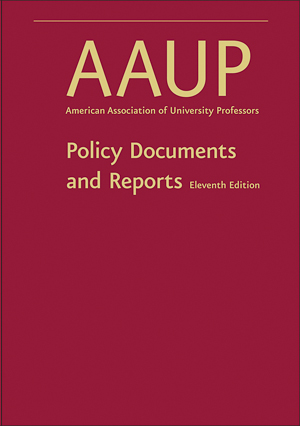 The centennial edition of the Redbook |
|
|
* Addendum: In June 2019, both the AAUP annual meeting and the AAUP-CBC regular meeting voted overwhelmingly to approve a proposed package of organizational changes that combined the AAUP-CBC and the AAUP. As of January 1, 2020, the AAUP-CBC was folded into the AAUP and former programs of the CBC became programs of the AAUP. |


